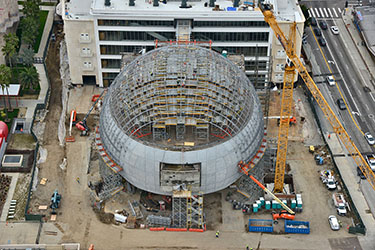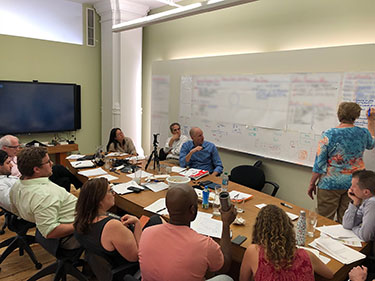|
Subscribe / Renew |
|
|
Contact Us |
|
| ► Subscribe to our Free Weekly Newsletter | |
| home | Welcome, sign in or click here to subscribe. | login |
Construction
| |

September 19, 2019
How a big-time project consultant learned to buff up its communication skills and connect with clients
Johnston Training Group

Johnston
|
From the Guggenheim Museum Bilbao in Spain to the Academy Museum of Motion Pictures in Los Angeles, Paratus Group has guided some of the world's biggest cultural institutions through their challenging and unique design and construction process. Capturing the owner's vision, choosing the architect who can bring that vision to life, hiring specialists who will preserve the historical aspects of the project, and finding engineers and contractors who can build multifaceted projects all have one thing in common: complexity.
In any one day, Paratus Group founder Andy Klemmer and his team of 14 may speak with an architect, a construction manager, an owner, a major donor for the project, and a government representative — all with a stake in the same project but with very different priorities and agendas. “We understand this process well from our experience. But if we can't communicate what we see well, we can't be effective in leading the client to success,” said Klemmer.
Clear and effective communication, both in person and in writing, is critical to bringing these parties together and successfully completing projects under intense public scrutiny during the design and building process.
To evaluate and strengthen their internal and client communication skills, Paratus Group turned to Johnston Training Group (JTG). JTG has served the architecture, engineering, construction industries for decades, enabling technical professionals to “convey their inner genius effectively” in proposals, during highly competitive project interviews, and in business development conversations.
WHERE TO IMPROVE
JTG principals Karen Johnston and Scott Johnston started the process by interviewing several Paratus Group clients about where communication was working and where it could be improved.
One client wanted information delivered in a summary format instead of extensive details he had to sort through. Another client wanted to hear about potential schedule challenges sooner so he could weigh options before recommendations were formed. A third client had noted grammar mistakes in routine communications.
Next, JTG interviewed each Paratus Group team member to get their take on specific challenges affecting effective communication. JTG asked them, “Where are the bottlenecks? Are you reinventing the wheel every month for the same communication?” JTG evaluated Paratus Group's written communications to identify where writing could be tighter, messages clearer, and grammar improved.
With a clear picture of Paratus Group's client perceptions, individual needs, and team needs, JTG designed a program to strengthen communication in writing, in person with clients, during interoffice communication, and in online meetings.
Sessions took place in Paratus Group offices in New York and Los Angeles over a year and JTG started with what the assessments revealed would make the biggest impact: writing monthly reports once instead of over and over, improving emails and executive summaries, and ensuring correct grammar throughout all communications.
THE READER'S PURPOSE
In the first session exercise, participants brought an example of something they had written to a client. Together, JTG and the group identified the writer's purpose (for example, explaining the advantages of hiring a construction manager) and the reader's purpose (to justify the choice to the board of directors). By identifying and focusing on the reader's purpose, Paratus Group team members provided more information the client would use and eliminated nonessential information that was more important to the writer.
EFFECTIVE PRESENTATIONS
JTG also evaluated each team member's presentations skills and developed a specialized program to strengthen in-person communication. The training got rid of “umms” and other filler words, made voices sound more confident, and improved body language. JTG shared techniques for quickly building and using stories that focus content on addressing the client's concerns and needs.
DEFINING PROJECT DIRECTION
Paratus Group calls what they do Project Direction, but team members were conveying the idea in different ways that rarely aligned.
After distilling all the input, a clear consensus emerged: While many firms do some of what Paratus Group does managing the design and construction of major cultural institutions, none were as heavily involved in the early visioning process, or played the same active role in managing the design. Paratus Group incorporates the project vision into the process well before design takes place and they carry it through every design decision all the way to construction completion. This is a critical differentiator because cultural institutions often start projects without setting a clear path from the visioning to successful design and construction. As a result their intentions are often lost or compromised along the way.
Once Project Direction was defined, the team developed stories from past experiences that could be shared to describe how Project Direction led to successful projects. Storytelling replaced a recitation of services and led to a more compelling presentation and a better means of connecting with potential clients.
BETTER COMMUNICATION
JTG training didn't just help with client communication. The program identified communication bottlenecks and situations in which team members were repeatedly fixing others' work or using different standards. By agreeing on a writing process and establishing guidelines easily accessible by all, Paratus Group team members saved time and improved the quality of all their communications.
Today, Paratus Group is connecting with clients (and potential clients) through productive conversations and clear, effective writing. Team members are all pulling in the same direction and spending less time rewriting the same materials repeatedly. As Paratus Group takes on new and even bigger projects, the firm is better equipped to navigate the challenging process of shepherding complex cultural institution projects from vision to completion.
Scott Johnston, Associate DBIA, is a principal at Johnston Training Group, which offers interview coaching, presentation skills and business development training programs for AEC firms.
Previous columns:
- Tree Farm building in Portland brought arborist on board with the design team, 09-12-2019
- Pentagon defers 127 building projects to construct 175 miles of Trump's border wall, 09-05-2019
- Crews will use buckling restrained braces to build Hedreen's Seattle hotel faster, 08-29-2019
- Here's why the county's $242M justice center project has so many apprentices working on it, 08-22-2019
- Long-awaited condo reform kicks in; here's what developers need to know, 08-15-2019
- Chehalis-based Pacific Mobile expands its trailer business on the West Coast, 08-08-2019
- Atlanta building where first country hit song was recorded may be replaced by ‘Margaritaville' hotel, 08-01-2019
- What role does gender play in AEC project interviews?, 07-25-2019




